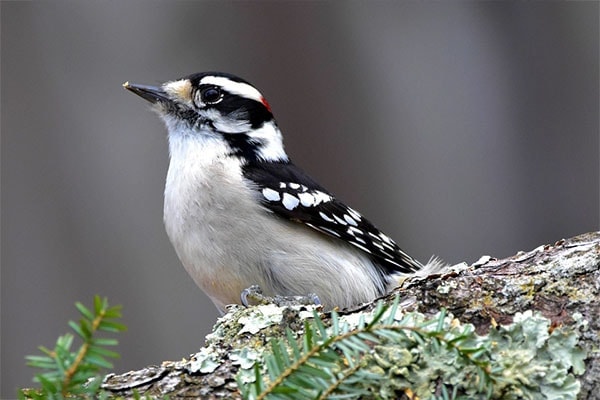
photo credit: Jack Bulmer from Pixabay
The Downy Woodpecker is a small version of the classic woodpeckers we usually see. They are widespread across the United States and have seven subspecies that differ in size and color pattern. They are also considered agricultural friends because they mainly eat agricultural pests.
In this article, we are going to cover a wide variety of topics related to the Downy Woodpecker, such as:
- How to identify them
- How, when, and where they migrate
- Their diet
- How and where they nest
- And much more…
So, without any more delay…
Let’s jump right into it and learn more about the Downy Woodpecker.
Downy Woodpecker Facts
- Common Name: Downy Woodpecker
- Scientific Name: Dryobates pubescens
- Scientific Family: Picidae
- Life Span: 2-5 years
- Size: 5.5 to 6.7 inches
- Wingspan: 9.8 to 11.8 inches
- Weight: 0.7 to 1.0 oz
- Conservation status: Least Concern
How To Identify A Downy Woodpecker
You can quickly identify a Downy Woodpecker because it’s generally smaller in size than a regular woodpecker. They feature a straight but short bill, they have broad shoulders, and their back is always straight while leaning away from the tree’s trunk.
These birds feature a color pattern of black and white. The head part is generally white with black stripes, their back and chest area is white, their wings are black with white dots. The tail area is also a combination of black in the center and white on the sides with black spots.
Differences Between Male & Female
An adult male and female Downy Woodpecker generally looks the same. However, one notable difference is that the males have a bright red spot on their nape.
Differences In Summer Plumage vs Winter Plumage
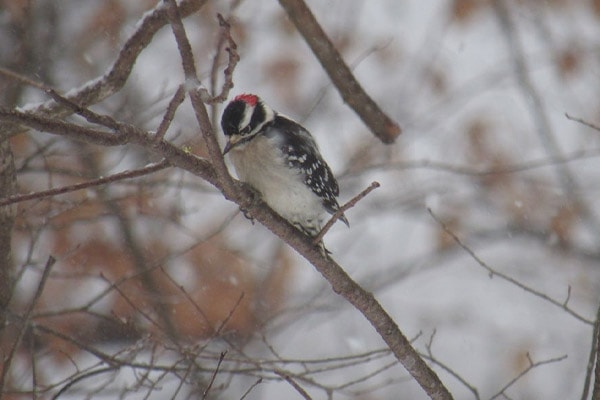
photo credit: Rachel Moore on Unsplash
You won’t be able to see any difference in the Downies plumage throughout the year. There are seven known subspecies by which size and color pattern can differ depending on the area where they’re found.
Downy Woodpecker Sounds
Where You’ll See A Downy Woodpecker
Downy Woodpeckers are spread out across the United States and southern Canada. They are often seen in deciduous open woodlands and along the streams. They even tend to live on high elevations of up to 9,000 feet.
As they are one of the most common visitors of bird feeders, and they just sometimes fly in open parks, towns, and suburbs. They also love staying on open shrubbery, swamps, farmland, and orchards.
Downy Woodpecker Migration Patterns
Downy Woodpeckers are known to be permanent residents of many areas. So, depending on where they’ve settled habitats, they just stay there. Although, there are some cases when some of them decide to travel long distances going south.
Diet and Feeding Preferences
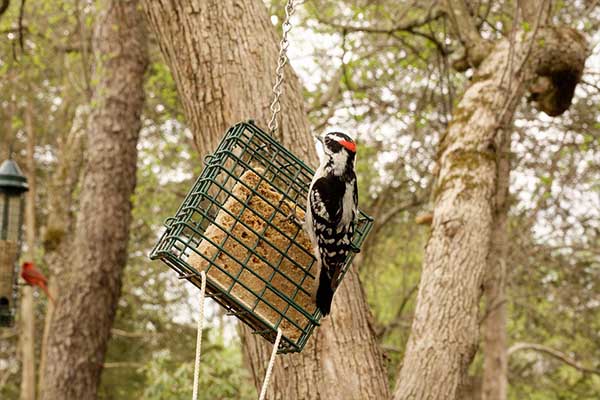
photo credit: Richard Emerson from Pixabay
About 75% of the Downies’ diet is composed mostly of insects. What’s great, though, is that they eat lots of agricultural pests like corn earworm, apple borers, beetle larvae, and corn earthworms, which is beneficial for us.
The remaining 25% is then composed of plant material like berries, acorns, and grains. They also love visiting bird feeders to eat suet and sunflower seeds.
Nesting Data
- Clutch Size: 3-8 eggs
- # of Broods: 1 brood
- Incubation Period: 12 days
- Nestling Period: 18-21 days
- Egg Description: White
Nesting
Both the male and female Downy Woodpeckers would choose a nest site, and this is most of the time on dead deciduous or dead parts of a deciduous tree. Both of them also help excavate the hole, which takes about 1-3 weeks to finish.
The holes are often 1-1.5 inches in diameter and about 6-12 inches deep, which is enough room for their eggs. They then line the cavity with wood chips for that soft and comfortable pad.
Downy Woodpecker Behavior
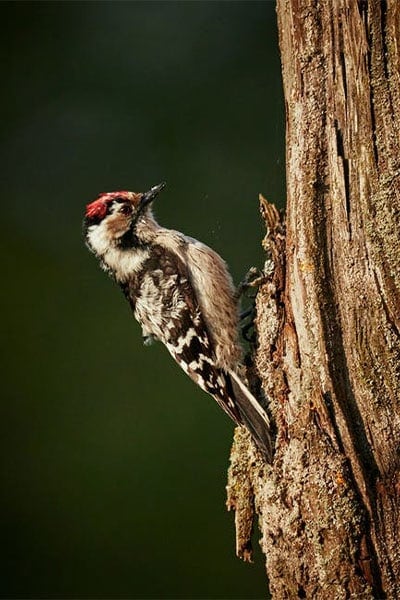
photo credit: Dariusz Grosa from Pexels
Downy Woodpeckers are diurnal birds that spend most of their time clinging to tree trunks and tree branches. They move very quickly and are often seen with their characteristic leaning pose with their tails stiffed for support.
They are observed to be more active than most woodpeckers despite their small size. They also opt to look for food alone, hopping on the ground or hammering on a tree.
These birds are also very territorial. When an intruder comes, they display threat by fanning their tails, raising their crest, and holding their bill high. If that won’t work, then the Downies would simply attack.
Tips for Birdwatchers On How To Attract Downy Woodpeckers
Downy Woodpeckers are very easy to attract as long as you can provide them with all their needs. Make sure that your backyard is set to have everything that a woodpecker would love:
- Insect-friendly yard
- Suet and sunflower seed
- Dead trees
- Shelter
- Drumming Site
- Birdbath
Purchase a hopper, platform, and suet feeder and place them in your backyard. You can use mealworms, peanut, suet, and sunflower seeds. Then, plant some trees and fruit-bearing and seed-bearing shrubs where the Downies can nest or eat fruits and seeds, too.
You might also want to build a birdhouse perfect for them. Added to that, create a drumming site, too. Lastly, provide a birdbath where they can swim or bathe.
Threats To The Downy Woodpecker
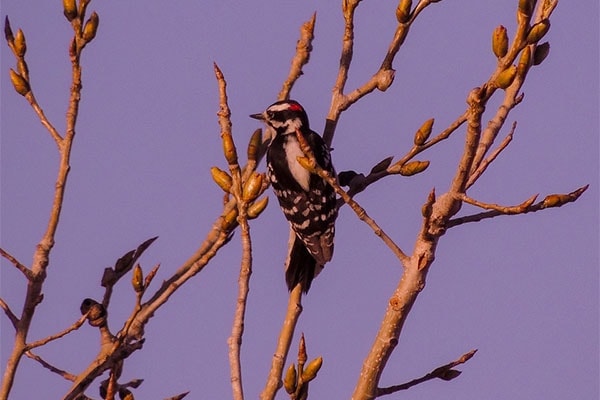
photo credit: Julie Jones from Pixabay
The population of Downy Woodpeckers has been stable for so many years. This is most probably because these birds are adaptable to any alterations in their natural habitats. However, predators are the most common threat. Among the most common ones are hawks, falcons, snakes, squirrels, rats, other woodpecker species, and domestic cats.
Fun & Interesting Facts
- Downy Woodpeckers have been a symbol of bravery and hard work.
- They have special features surrounding their nostrils that prevent them from breathing in wood chips.
- There’s a spongy elastic material between their bill and skull that protects their brain from shock.
- Downies create excavates on areas hidden by fungus or lichens for some camouflage.
- They don’t sing songs but drum loudy instead.
- The oldest recorded Downy Woodpecker lived for 11 years and 11 months.
Explore More Species in This Family
- Williamson’s Sapsucker
- Yellow-bellied Sapsucker
- Red-naped Sapsucker
- Red-breasted Sapsucker
- Lewis’s Woodpecker
- Red-headed Woodpecker
- Acorn Woodpecker
- Gila Woodpecker
- Golden-fronted Woodpecker
The post Downy Woodpecker: Bird Identification, Habits, Facts, Nesting appeared first on BirdInformer.com.
from BirdInformer.com https://ift.tt/3ceupFO

No comments:
Post a Comment